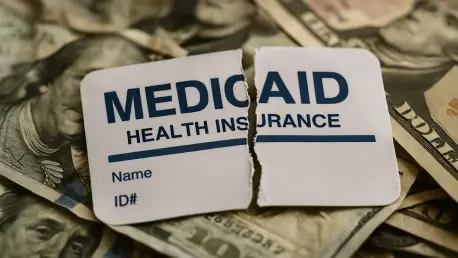The passage of the One Big Beautiful Bill Act (OBBB Act) on July 4 of this year has unleashed a seismic shift in the U.S. healthcare landscape, promising federal savings of $326 billion over the next decade while introducing severe Medicaid work requirements that could reshape the system. This legislation mandates that expansion adults aged 19 to 64 complete 80 hours of work or qualifying activities monthly to maintain coverage, a policy that could disenroll millions. With the Congressional Budget Office (CBO) projecting a loss of 5.2 million enrollees by 2034, the stakes are alarmingly high, threatening not only public health but also the financial stability of providers and investors. This discussion delves into the cascading effects of these cuts, exploring how they jeopardize access to care, strain healthcare infrastructure, and create a volatile environment for financial markets, painting a sobering picture of systemic risk and hidden costs.
Healthcare System Under Siege
Immediate Impact on Coverage and Access
Enrollment Barriers and Projected Losses
The OBBB Act’s stringent work requirements stand as a formidable obstacle to Medicaid coverage, with projections estimating that 5.2 million adults could lose eligibility by 2034, leaving 4.8 million uninsured. This isn’t merely a statistical forecast but a stark warning of diminished access for those already on the margins of the healthcare system. The policy demands 80 hours of work or qualifying activities each month, coupled with a rigorous verification process that includes look-back periods of up to six months. Even with exemptions for caregivers, the medically frail, and individuals with disabilities, the administrative hurdles are likely to exclude many who qualify. States like New York and Georgia face particularly steep enrollment declines, with New York alone projected to lose 1.5 million enrollees over a decade. This sharp reduction signals a profound shift in healthcare access, disproportionately impacting communities least equipped to navigate such barriers and setting the stage for broader systemic challenges.
Deepening Disparities in Vulnerable Communities
Beyond the raw numbers, the OBBB Act risks widening existing healthcare disparities, particularly among low-wage workers in sectors like retail and hospitality where employer-sponsored insurance remains elusive. For many Medicaid enrollees, the reality of fluctuating hours and unstable employment makes meeting the 80-hour monthly requirement nearly impossible, thrusting them into a coverage gap. This loss of insurance often translates into delayed medical care, skipped preventive screenings, and worsening chronic conditions, further entrenching health inequities. Historical precedents from states like Arkansas and Georgia, where similar mandates resulted in thousands losing coverage, underscore the potential for harm. The ripple effects extend beyond individuals to entire communities, where reduced access to care can exacerbate public health challenges, strain local resources, and diminish overall well-being, highlighting a critical flaw in a policy meant to encourage self-reliance but instead fosters exclusion.
Strain on Providers and Insurers
Hospitals Facing Operational Crises
Safety-net hospitals, long the backbone of care for underserved populations, now confront a dual threat under the OBBB Act: a surge in uncompensated care and a steep drop in Medicaid revenue. As millions lose coverage, emergency departments are expected to become the default care setting for the uninsured, driving up costs that hospitals must absorb without reimbursement. In New York, the projected loss of 1.5 million Medicaid enrollees over the next decade could devastate the state’s healthcare economy, slashing critical funding streams for facilities already operating on thin margins. This financial strain threatens not only day-to-day operations but also the ability to invest in staff, equipment, and infrastructure improvements. The burden falls heaviest on urban and rural hospitals serving high-need areas, where the influx of uninsured patients could push some facilities toward closure, leaving entire regions without essential medical services and amplifying the crisis.
Insurer Market Instability and Premium Pressures
Insurers, too, are grappling with the fallout of the OBBB Act, as the shrinking Medicaid risk pool and tightened subsidies in the Affordable Care Act (ACA) Marketplace create a volatile business environment. With fewer enrollees, the financial stability of Medicaid plans weakens, while restrictions on premium tax credits for those disenrolled under work requirements drive up costs for remaining consumers. This dynamic has already prompted premium hikes in some regions and forced certain insurers to exit markets altogether, a trend observed in states like Georgia with aggressive mandates. The instability extends to the ACA Marketplace, where a smaller, sicker risk pool exacerbates financial pressures, threatening the viability of affordable coverage options. As insurers navigate these challenges, the broader implication is a fragmented healthcare market, where access to plans becomes more limited and expensive, further complicating the landscape for both consumers and industry stakeholders.
Public Health and Economic Fallout
Deteriorating Health Outcomes
Surge in Delayed Care and Emergency Overload
The loss of Medicaid coverage for millions under the OBBB Act is poised to trigger a significant rise in delayed medical care, with profound consequences for public health. Without insurance, many low-income adults are likely to forgo routine checkups, chronic disease management, and early interventions, conditions that often escalate into emergencies requiring costly hospital care. Emergency rooms, already stretched thin in many areas, face an impending overload as the uninsured turn to them as a last resort. This shift not only strains hospital resources but also leads to poorer health outcomes, as conditions that could have been managed with primary care become acute. The CBO’s projection of 4.8 million uninsured by 2034 underscores the scale of this issue, painting a grim picture of increased suffering and preventable hospitalizations that could have been avoided with sustained access to coverage.
Long-Term Impact on Community Health
Beyond the immediate spike in emergency care, the broader impact of coverage losses on community health cannot be overstated. Preventable hospitalizations for conditions like diabetes and hypertension are expected to climb as individuals lose access to consistent medical oversight, creating a cycle of declining health and rising costs. This trend disproportionately affects vulnerable populations, including racial and ethnic minorities and those in rural areas with limited healthcare options, further deepening systemic inequities. Public health initiatives, often reliant on state funding tied to Medicaid enrollment, may also suffer, reducing outreach for vaccinations, screenings, and disease prevention. The long-term erosion of community well-being threatens to reverse years of progress in health metrics, burdening not just individuals but entire regions with the consequences of a policy that prioritizes fiscal savings over sustained access to essential care.
State Budget Challenges
Mounting Fiscal Pressures on States
States are staring down a daunting fiscal challenge as the OBBB Act’s Medicaid cuts translate into massive budget shortfalls, with places like New York potentially facing a $3 billion deficit to cover uncompensated care. This financial hole stems from the need to address the surge in uninsured patients seeking emergency services, costs that often fall on state and local governments when federal support diminishes. The burden is compounded for states with large noncitizen populations losing ACA subsidies under the new rules, further straining resources. Such shortfalls leave policymakers with tough choices—either slash public health programs critical to disease control and maternal care or raise taxes, both of which risk stunting economic growth. The scale of this economic pressure highlights a critical oversight in the legislation, where federal savings come at the expense of state stability and local resilience.
Economic Ripple Effects Across Communities
The economic fallout from state budget deficits extends far beyond government balance sheets, permeating local communities and businesses in ways that could reshape regional economies. As states cut funding for public health or increase taxes to offset uncompensated care costs, small businesses and low-income households bear the brunt, facing higher costs and reduced services. In areas heavily reliant on Medicaid-driven healthcare jobs, such as rural regions, enrollment drops could lead to layoffs or closures at hospitals and clinics, further depressing local economies. The interconnected nature of healthcare spending means that a $3 billion shortfall in a state like New York doesn’t just impact government—it stifles consumer spending, slows job growth, and undermines community vitality. This cascading effect serves as a stark reminder that healthcare policy is not an isolated issue but a cornerstone of broader economic health, with repercussions felt at every level of society.
Investment Risks and Opportunities
Sectors at Risk
Financial Instability in Medicaid-Dependent Industries
For investors, the OBBB Act introduces significant risks in sectors heavily tied to Medicaid, particularly among certain insurers and regional hospitals. With enrollment projected to plummet by 5.2 million over the next decade, these entities face declining revenue streams and heightened liquidity challenges, especially in states like Georgia and Wisconsin enforcing strict work mandates. Insurers managing Medicaid plans risk shrinking profit margins as the risk pool contracts, while hospitals confront rising bad debt from uncompensated care. Financial reports from safety-net facilities already signal distress, with some teetering on the edge of insolvency under the weight of reduced reimbursements. This environment demands caution, as the potential for sudden market shifts and operational failures looms large, threatening portfolios exposed to these vulnerable segments of the healthcare industry.
Regional Vulnerabilities and Market Shocks
The risks are not evenly distributed, with regional disparities amplifying the impact on Medicaid-dependent sectors. Hospitals in high-poverty areas or states with aggressive implementation of work requirements face a heightened threat of financial collapse, as their patient base is disproportionately affected by coverage losses. Insurers operating in these markets may encounter abrupt market shocks, such as unexpected premium spikes or forced exits from unprofitable regions, as seen in Georgia’s past experiments with similar policies. These localized pressures create a patchwork of risk for investors, where a single state’s enrollment drop can ripple through national portfolios. Monitoring state-level data and hospital financials for early warning signs of distress becomes critical, as the uneven rollout of the OBBB Act’s mandates could catch unprepared stakeholders off guard, leading to significant and avoidable losses in an already turbulent market.
Defensive Plays for Investors
Growth Potential in Adaptive Industries
Amid the uncertainty unleashed by the OBBB Act, defensive opportunities emerge for investors willing to pivot toward industries poised to adapt to systemic strain. Medical device manufacturers, for instance, stand to gain from increased demand for emergency care equipment as uninsured patients flood hospital settings. Telehealth platforms like Teladoc Health are also well-positioned to capture a growing market of individuals seeking affordable care alternatives outside traditional systems. Additionally, revenue cycle management firms, such as Change Healthcare, are likely to see a surge in business as providers grapple with the administrative chaos of Medicaid verification processes. These sectors offer a buffer against the downturns in Medicaid-dependent areas, providing a pathway for portfolios to weather the storm by capitalizing on the shifting needs of a healthcare landscape under duress.
Strategic Positioning for Long-Term Gains
Investors looking to secure long-term gains in this volatile environment should focus on strategic positioning within these adaptive industries, using key milestones like state implementation deadlines through 2026 and 2027 as guideposts for action. Tracking hospital earnings for rising bad debt and insurer reports for Marketplace stability offers actionable insights into where risks are mounting and opportunities are ripening. The demand for telehealth and medical devices is not a fleeting trend but a structural shift, as patients and providers seek sustainable solutions to coverage gaps. Building exposure to these resilient sectors, while divesting from high-risk Medicaid-heavy investments, can create a balanced approach to navigating the fallout. Success hinges on agility and foresight, ensuring that capital is directed toward areas of growth rather than entrenched in segments facing inevitable decline under the weight of policy-driven disruption.









